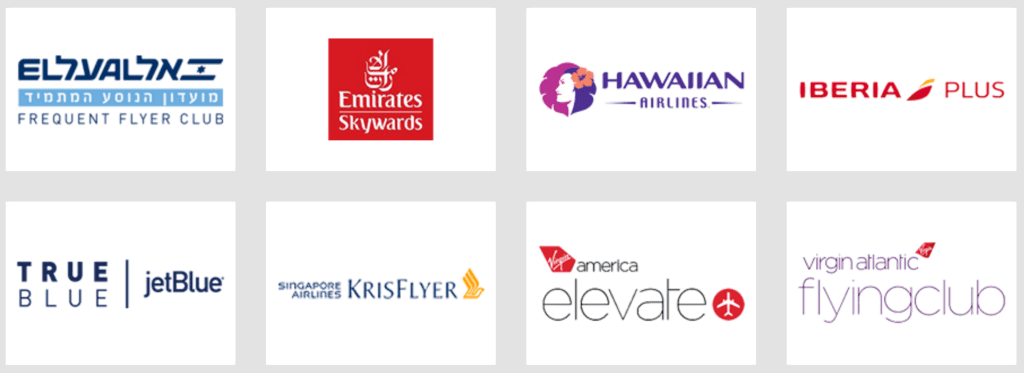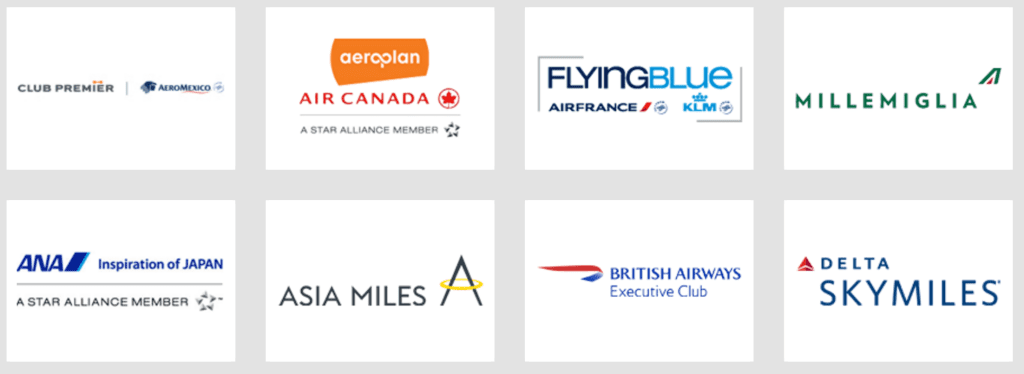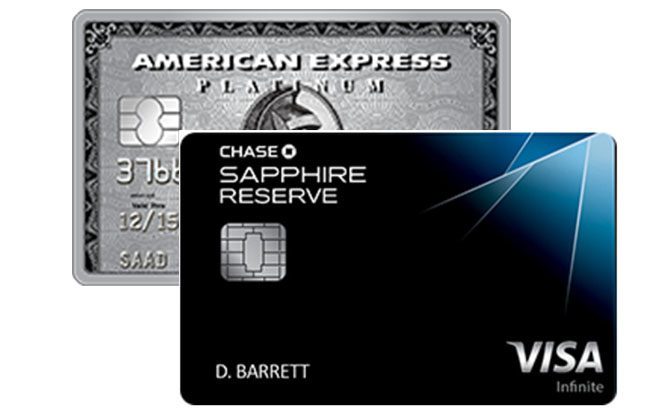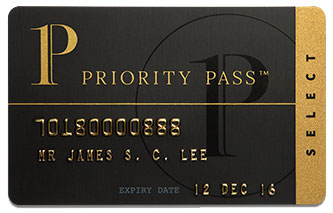The Chase Sapphire Reserve is the newest benefits card to hit the market and consumers are going crazy over this card (and rightfully so). It’s a bit of a super-card, offering an outstanding sign-up bonus, some of the best benefits out of any card, and great bonus category earning rates. But how does is stack up to the tried-and-true Platinum Card from American Express? Here’s a comparison between the two cards with a final winner decided at the end.
Update: Some offers are no longer available — click here for the latest deals!
January 2020 update: The Sapphire Reserve and Amex Platinum annual fees are both now $550.
Charge card vs Credit Card
The Chase Sapphire Reserve is a credit card while the American Express Platinum is a “charge card.” A charge card must be paid off in full each month or else you face a hefty monthly fee. The benefit to a charge card like the Platinum is that you’re not restricted to a strict credit limit and so you have a little more spending flexibility (although credit limits with the Reserve tend to start quite high so it’s not a huge advantage here).
Note: Over time, you can often effectively turn your charge card into a credit card with Amex with the “Pay Over Time” feature.
Transfer Partners
Membership Rewards
The Platinum will earn you Membership Rewards that can be transferred to a variety of travel partners listed below:
Airlines


These partners do not have all have the same transfer ratios as you can see below:
- Delta Skymiles
- Club Premier AeroMexico
- Aeroplan Air Canada
- Flying Blue (Air France/KLM)
- MilleMigilia Club Alitalia
- ANA
- Asia Miles
- Avios British Airways (250 points = 200 Avios)
- Emirates Skyrewards
- Hawaiin Airlines
- Iberia Plus
- JetBlue
- KrisFlyer Singapore Airlines
- Virgin America (200 points = 100 Elevate points)
- Virgin Atlantic
Hotels
- Best Western Rewards
- Choice Privileges
- Hilton HHonors (1,000 points = 1,500 HHonors points)
- SPG (Starwood Preferred Guest) (1,000 points = 333 Starpoints)
There are a few things to keep in mind about Membership Rewards:
- Bonus transfers are occasionally offered allowing you to transfer your points to partners for higher ratios. Check this thread for a history of these transfer bonuses.
- Your Membership Rewards cannot be freely transferred between you and any friend or family members but you can transfer them to authorizes users’ rewards accounts.
- They don’t expire as long as you remain a cardholder
Chase Ultimate Rewards
The Sapphire Reserve earns “Ultimate Rewards” that can all be transferred at a 1:1 ratio to a variety of travel partners listed below.
Airlines
- British Airways Executive Club
- Flying Blue (Air France/KLM)
- Korean Air SKYPASS
- Singapore Airlines KrisFlyer
- Southwest Airlines Rapid Rewards
- United MileagePlus
- Virgin Atlantic Flying Club
Hotels
- Hyatt Gold Passport
- IHG® Rewards Club
- Marriott Rewards
- The Ritz-Carlton Rewards
Which reward program is better?
Both programs have their strengths and weaknesses and lots could be written in a comparison between the two but here’s a brief look at some of the key highlights of the travel partners.
Membership Rewards
- ANA – Super cheap redemptions, such as 88,000 miles in business class to Europe and very reasonable prices to other destinations like Asia (Japan), South America, Africa, etc.
- Aeroplan – Good redemption rates to places like Europe and an easy way to avoid surcharges on Star Alliance partners, such as United Airlines.
- Delta – Amex has several Delta credit cards making it easy to top off.
- MilleMigilia Club Alitalia – Sometimes a little hassle involved with redeeming but excellent redemption rates to many places, such as South American and Africa.
Chase Ultimate Rewards
- Korean Air – Super cheap redemptions, such as at 80,000 miles in business class to Europe and some of the best prices to Hawaii, South America, and the Caribbean.
- British Airways – the 1:1 transfer ratio is superior to Membership Rewards and BA can be great for short-haul flights around the country or even getting to Europe and other places.
- Southwest – Very cheap routes available to get around the country. If you obtain the Companion Pass and you essentially double the value making them a super-economical way to get around the US and Caribbean; miles can be quickly obtained with Chase Southwest cards.
- United – Tons of flight options with huge network around the US and globe; miles can be quickly obtained with Chase United cards.
Membership Rewards and Chase Ultimate Rewards
Two partners overlap each program:
- Singapore Airlines – Also a transfer partner of Citi; Singapore Airlines has a tremendous business class and first class products and some very reasonable redemption rates.
- Flying Blue – Also a transfer partner of Citi; great way to book with SkyTeam partners to places like Europe.
And as far as hotel partners go, I’d roll with Ultimate Reward partners Hyatt, Marriott, and IHG over the transfer ratios for SPG and Hilton.
As you can see both programs have many options for booking great redemptions to just about anywhere you want to go in the world. In the end, unless you have a very clear plan as to what loyalty program you’ll be utilizing, it’s hard to go wrong with either program. Once you learn the system for redeeming miles with alliance partners, you’ll see that both of these reward programs have tons to offer depending on your personal goals for your travel. For that reason, I’m declaring it mostly a draw with a slight edge to Ultimate Rewards for its better transfer ratios and hotel partners.
Redeeming Points
In addition to transferring points to travel partners you can always redeem your points in different ways, such as for cash back, gift cards, or to book travel.
Membership Rewards
Membership Rewards can be redeemed in the following ways:
- Between .5 and 1.0 cent per point for gift cards
- 0.6 cent per point for a statement credit/charge.
- 1.0 cent per point on air fare
- 0.7 cent per point on hotels, cruises, and vacation packages.
Chase Ultimate Rewards Portal
Ultimate Rewards can be redeemed in the following ways:
- 1.0 cent per point for cash back into your Chase checking or savings account.
- 1.0 cent per point for gift cards
- As a Chase Sapphire Reserve card holder, if you book travel through the Ultimate Rewards Portal you can redeem points as 1.5 cents per point.
The Reserve easily beats the Platinum with these redemption options. Although I always transfer my points out to travel programs, 1.5 cents per point redemption on any travel is solid and very tempting, especially when compared to what you’re given with the Platinum. And while I definitely would never redeem Ultimate Rewards for a statement credit, the points to redeem at one cent per point almost double the rate of Membership Rewards. Thus, the Sapphire Reserve is the clear winner here.
Sign-up Bonus
Platinum Card
New bonus of 60K is out — will update article soon.
- 40K to 100K (currently 40K) when you spend $3,000 in the first 3 months.
The 40K offer is the standard offer available to the public, and the 100K offer comes around in three forms but there’s no guarantee that you will ever get it. The three forms it comes in are:
- 1) Targeted mailings (if you’re already an Amex cardholder your chances of getting this offer in the mail are slim to none).
- 2) Pre-approval links: Some sites (including the Amex site) that allow you to view your pre-approved credit card offers will show this offer.
- 3) Incognito/Private browser windows sometimes show this offer (rare)
Tip: When applying for bonuses with Amex cards always remember that bonuses for personal cards are only given once a lifetime.
Sapphire Reserve
- 50K when you spend $4,000 in the first 3 months
The drawback to the Reserve is that it’s subject to the Chase 5/24 rule, meaning that if you’ve opened up 5 or more accounts in the past 24 months, you won’t be approved subject to certain limited exceptions.
Bonus Categories
Platinum Card
October 7, 2016 update:
- 5X on purchases of airfare made directly with airlines
- 1X on all other purchases
Sapphire Reserve
- 3X on travel
- 3X on dining
- 1X on all other purchases
This is another lopsided comparison in favor of the Sapphire Reserve. 3X on travel and dining is extremely competitive even among non-benefit based cards, so the Reserve definitely stands out in this regard.
Benefits
The real reason you apply for and keep a credit card with an annual over $400 is for the benefits that the card offers.
Platinum Card
Here’s a breakdown of my favorite benefits of the Platinum, but in a nutshell this card confers a host of benefits to you making it worth it including:
- Priority Pass airport lounge access (worth $400 per year)
- Centurion Lounge Access/Delta Lounge Access (when you fly with them)
- $200 annual airline credit (essentially reducing the annual fee to $250)
- $100 statement credit for Global Entry/TSA Pre-Check
- Add up to 3 authorized users for only $175 per year (for all 3)
- Gold status with Hilton and Starwood
- Free Boingo Wifi subscription (worth $120 per year)
- Rental car benefits with National Car Rental, Avis, and Hertz
- Concierge service
Also, while not exclusive to the Platinum, Amex Offers (which are special discounts and rebates given to Amex cardholders) can add up quickly if used efficiently and can certainly act as a considerable benefit to having the Platinum.
Sapphire Reserve
- Priority Pass airport lounge access (worth $400 per year)
- $300 annual travel credit (essentially reducing the annual fee to $150)
- $100 statement credit for Global Entry/TSA Pre-Check
- Add authorized users for $75 per person
- Rental car benefits with National Car Rental, Avis, and Silvercar
- Visa Infinite concierge service
- Elite Hotel Benefits at Relais & Châteaux
Primary rental car insurance
Platinum Card
- Excess rental car insurance (may cover what your insurance company doesn’t cover), subject to exceptions such as no coverage for exotic cars and cars with retail value over $75,000.
Chase Sapphire Reserve
- The Sapphire Reserve offers primary rental car insurance covering up to $75,000. This benefit comes with fewer restrictions than the Sapphire Preferred had.
Primary rental car coverage is a huge benefit offered by the Sapphire Reserve because it can save you from having to file a claim with your insurance company and keep your premiums down.
Travel protections
Lost or damaged Luggage
Platinum Card
- Will pay a benefit for the Replacement Cost, up to $3,000, for each Covered Person on a Covered Trip for Loss of carry-on Baggage.
- Will pay a benefit for the Replacement Cost, up to $2,000, for each Covered Person on a Covered Trip for Loss of checked Baggage
Chase Sapphire Reserve
- For checked or carry-on bags are damaged or lost by the carrier, you’re covered up to $3,000.00 for each Insured Person for each Common Carrier Covered Trip and up to $500.00 for each Insured Person for each Common Carrier Covered Trip for jewelry, watches, cameras, video recorders, and other electronic equipment.
Additional Benefits
The Sapphire Reserve has many other travel benefits, too. These include:
- Trip Interruption: If your trip is canceled or cut short by covered situations, you can be reimbursed up to $10,000 per trip for your pre-paid, non-refundable travel expenses,
- Trip Delay Reimbursement: If delayed more than 6 hours you are covered for expenses, such as meals and lodging, up to $500 per ticket. (upgrade from the Sapphire Preferred which required 12 hours).
- Baggage Delay Reimbursement: If delayed more than 6 hours, you are covered for essential expenses, such as toiletries and clothes for up to one hundred ($100.00) dollars per day for a maximum of five (5) days.
For the Platinum, you’d have to purchase travel insurance before your trip to get these benefits. Thus, the Sapphire Reserve is a far superior travel credit card in this regard.
Purchase protections
A) Purchase protections
Platinum Card
- Covers your new purchases for 90 days against damage or theft up to $10,000 per claim and $50,000 per Card Member account per calendar year.
Chase Sapphire Reserve
- Covers your new purchases for 120 days against damage or theft up to $10,000 per claim and $50,000 per account. (This is a significant upgrade from the previous $500 limit of the Sapphire Preferred.)
B) Extended Warranty Protection
Platinum Card
- Provides one additional year if the original manufacturer’s warranty is between one year and five years limited up to a maximum of USD $10,000 per occurrence
Chase Sapphire Reserve
- Extends the time period of the original manufacturer’s written U.S. repair warranty by one (1) additional year on eligible warranties of three (3) years or less, up to a maximum of ten thousand ($10,000.00) dollars per claim
C) Price Protection
Platinum Card
- No price protection offered
Chase Sapphire Reserve
- If a card purchase you made in the U.S. is advertised for less in print or online within 90 days, you can be reimbursed the difference up to $500 per item, $2,500 per year.
D) Return Protection
Platinum Card
- You can be reimbursed for eligible items that the store won’t take back within 90 days of purchase, up to $300 per item, $1,000 per year.
Chase Sapphire Reserve
- You can be reimbursed for eligible items that the store won’t take back within 90 days of purchase, up to $500 per item, $1,000 per year.
Travel accident insurance
Platinum Card
- Up to $500,000 for loss of life
Chase Sapphire Reserve
- Up to $1,000,000 for loss of life
Roadside assistance
Platinum Card
- Free for up to 4 times per year for the following services: towing up to 10 miles, winching, jump starts, flat tire change when Card Member has a workable spare, lockout service when key is in vehicle and delivery of up to 2 gallons of fuel.
Chase Sapphire Reserve
- Free for up to $50 and up to 4 times per year
Foreign Transaction Fees
- Both cards have no foreign transaction fees.
Annual Fee
Platinum Card
- $450, not waived (more like $250/year with airline credit)
Chase Sapphire Reserve
- $450, not waived (more like $150/year with airline credit)
While the annual fees are the same one aspect where the Reserve comes out on top is that you should be able to downgrade it to a no annual fee card like a Freedom or regular Sapphire. With the Platinum, the best you can do aside from canceling it is to downgrade it to a Green Card with a $95 fee.
Highlighting the Differences
Lounge Access and hotel status
The Platinum card has a leg up on the Reserve when it comes to lounge access and hotel perks. The access to Centurion lounges (and free entry for up to two guests or immediate family members) and Delta SkyClub lounges (when you fly with them) can be huge for those who frequent them. In addition, having complimentary gold hotel status with Hilton and SPG (and now Marriott) is a nice perk that’s afforded me several upgrades. Thus, if you’re concerned primarily about lounge access and will actually frequent Centurion and Delta lounges, the Platinum card might be better suited for you to hold on to in the long-term.
I’m still awaiting confirmation of the guest policy of the Priority Pass with the Reserve. Early indications are that guests will be allowed subject to the discretion of the lounge. (I will update when facts emerge.)
Update: It’s now confirmed that the Sapphire Reserve Priority Pass access allows complimentary access to you and the guests in your “travel party.” Which means all the guests accompanying you can enter subject to availability and the rules of the lounge (some lounges restrict guest access to always try to check ahead of time).
Travel credit
The Sapphire Reserve stands out for its $300 travel credit. This travel credit can be applied to anything that falls under the travel category. This is extremely broad and makes it ridiculously easy to take advantage of the travel credit.
The Platinum, on the other hand, limits this travel credit to incidentals for one single domestic airline. While there are easy ways to get around this with gift cards or through the MPX app, for many people it still doesn’t compare to the ease and breadth of the Sapphire Reserve travel credit (not to mention it’s $100 more).
The travel credit on expensive credit cards like these is important because it allows you to offset the annual fee making what you effectively pay for the card much more reasonable. In this case, you’re essentially paying $150 for the Sapphire Reserve and $250 for the Platinum, making the Reserve a better card to hold onto it the long term for people primarily concerned with paying the lowest annual fee possible.
Bonus categories
The Platinum earns 5X on purchases made directly with an airline and 1.5X on purchases of $5,000 or more, but the Sapphire Reserve earns 3X on dining and travel. The 1.5X on huge purchases probably doesn’t mean much to most consumers and you can always pair the Reserve with the (no annual fee) Freedom Unlimited and earn 1.5X on all purchases, so it’s not a huge win for the Platinum there.
The 5X on airfare can be nice but it still won’t be worth it to ditch the Reserve’s 3X on travel for a lot of people (see my article here on keeping both the Sapphire Reserve and the Platinum).
Overall, the Reserve’s 3X on dining and travel huge for people like myself who spend well over $3,000 each year in dining and travel. That’s because it only takes about that amount of spending to make it worth keeping the Sapphire Reserve over the Sapphire Preferred. Furthermore, these bonus earnings just bring even more value to the Reserve that the Platinum card simply can’t compete with. Thus, based on your spending habits, the bonus categories alone can make the Reserve the more economical option over the Platinum in the long-run.
Authorized users
The Platinum card requires you to pay a flat fee of $175 to add an authorized user but allows up to three to be added for that price, while the Reserve requires you to pay $75 for each authorized user. The authorized users receive the key benefits like lounge access, status, etc. This means that if you just want to add one authorized user the Reserve will save you $100 but if you’re going to add 3, you’ll be paying more out of pocket with the Reserve ($225) than you would with the Platinum ($175).
Protections
Both cards offer great protections for purchases but the Reserve definitely trumps the Platinum overall. First, the primary rental car coverage is a huge point in favor of the Reserve. Second, the Platinum doesn’t even offer complimentary travel/baggage delay protection. Also, when you run down the list of other travel/purchase protections the Reserve wins in just about everything except for extended warranty coverage.
Final Word
The Reserve outshines the Platinum Card in almost every category. I really think that that only reason to hold onto the Platinum over the Reserve is if you’re going to get your money’s worth out of frequent visits to Centurion lounges or Delta lounges. Otherwise, the Sapphire Reserve is the better option almost all the way across the board. With that said, if you can swing a 100K bonus for both of these cards, I think it’s worth to get them both but maybe only hold on to the Reserve for the long-term.
Daniel Gillaspia is the Founder of UponArriving.com and the credit card app, WalletFlo. He is a former attorney turned travel expert covering destinations along with TSA, airline, and hotel policies. Since 2014, his content has been featured in publications such as National Geographic, Smithsonian Magazine, and CNBC. Read my bio.




I HAVE SEEN DIFFERENT COSTS/YEAR FOR THE CHASE SAPPHIRE RESERVE- $95 AND NOW $450. WHICH IS IT? WHEN WAS THE RATE CHANGED, IF IT WAS?
CAN I FLY MOSTLY DELTA, DOES THIS RULE OUT CHASE FOR POINTS, SERVICES FOR FLYING?
DOES IT MAKE A DIFFERENCE THAT I DON’T HAVE A CHASE BANK ACCT?
Hi James, so the Chase Sapphire RESERVE has the $450 fee but the Chase Sapphire PREFERRED has the $95 fee. You can use Chase Ultimate Rewards to fly Delta by transferring points to SkyTeam partners Flying Blue and Korean Air (Flying Blue being much easier). An alternative to that would be to go with Amex which offers several Delta cards and can transfer to Delta. Finally, having a Chase bank account can help a little bit with getting approvals if you’re a borderline candidate but it’s by no means a prerequisite for getting approved for Chase cards.